

Compact Muon Solenoid
LHC, CERN
| CMS-EXO-21-007 ; TOTEM-2023-003 ; CERN-EP-2023-143 | ||
| Search for high-mass exclusive diphoton production with tagged protons in proton-proton collisions at $ \sqrt{s} = $ 13 TeV | ||
| CMS and TOTEM Collaborations | ||
| 5 November 2023 | ||
| Phys. Rev. D 110 (2024) 012010 | ||
| Abstract: A search is presented for high-mass exclusive diphoton production via photon-photon fusion in proton-proton collisions at $ \sqrt{s} = $ 13 TeV in events where both protons survive the interaction. The analysis utilizes data corresponding to an integrated luminosity of 103 fb$ ^{-1} $ collected in 2016--2018 with the central CMS detector and the CMS and TOTEM precision proton spectrometer (PPS). Events that have two photons with high transverse momenta ($ p_{\mathrm{T}}^{\gamma} > $ 100 GeV), back-to-back in azimuth, and with a large diphoton invariant mass ($ m_{\gamma\gamma} > $ 350 GeV) are selected. To remove the dominant inclusive diphoton backgrounds, the kinematic properties of the protons detected in PPS are required to match those of the central diphoton system. Only events having opposite-side forward protons detected with a fractional momentum loss between 0.035 and 0.15 (0.18) for the detectors on the negative (positive) side of CMS are considered. One exclusive diphoton candidate is observed for an expected background of 1.1 events. Limits at 95% confidence level are derived for the four-photon anomalous coupling parameters $ |\zeta_1| < $ 0.073 TeV$^{-4} $ and $ |\zeta_2| < $ 0.15 TeV$^{-4} $, using an effective field theory. Additionally, upper limits are placed on the production of axion-like particles with coupling strength to photons $ f^{-1} $ that varies from 0.03 TeV$^{-1} $ to 1 TeV$^{-1} $ over the mass range from 500 to 2000 GeV. | ||
| Links: e-print arXiv:2311.02725 [hep-ex] (PDF) ; CDS record ; inSPIRE record ; HepData record ; CADI line (restricted) ; | ||
| Figures | |

png pdf |
Figure 1:
Diagram of diphoton production via photon fusion with intact protons in the final state. The four-photon vertex includes virtual contributions from SM or BSM charged fermions or bosons. In other BSM scenarios, a new heavy particle can be produced in the $ s $-channel, such as an axion-like particle that decays into two photons. |

png pdf |
Figure 2:
A schematic view of one side of the PPS detector with respect to the central CMS detector. The stations labeled as (or located at) 210 and 220\unitm house the Roman Pot detectors. Timing detector stations are also shown, although they are not used in this analysis. A symmetric set of detectors exists on the opposite side of CMS as well. |
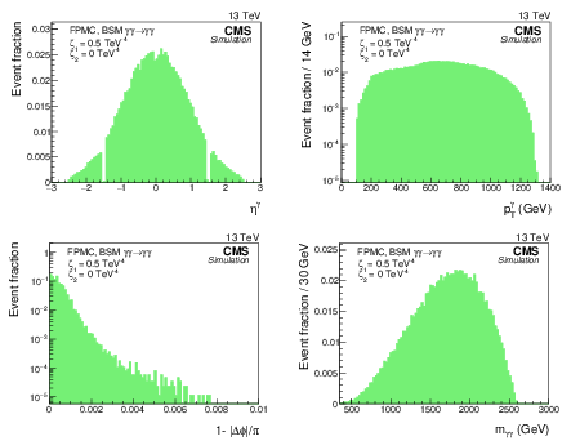
png pdf |
Figure 3:
Kinematic distributions of simulated aQGC $ \gamma\gamma \to \gamma\gamma $ events: Single-photon $ \eta $ (upper left) and $ p_{\mathrm{T}} $ (upper right), and diphoton acoplanarity (lower left) and mass (lower right). The events are generated with FPMC, reconstructed accounting for the full CMS detector response, for aQGC parameters $ \zeta_1 = $ 0.5 TeV$^{-4} $ and $ \zeta_2 = $ 0 TeV$^{-4} $. A preselection is applied to these events as described in Section 5. |

png pdf |
Figure 3-a:
Distribution of the diphoton mass in simulated aQGC $ \gamma\gamma \to \gamma\gamma $ events. The events are generated with FPMC, reconstructed accounting for the full CMS detector response, for aQGC parameters $ \zeta_1 = $ 0.5 TeV$^{-4} $ and $ \zeta_2 = $ 0 TeV$^{-4} $. A preselection is applied to these events as described in Section 5. |

png pdf |
Figure 3-b:
Distribution of the single-photon $ p_{\mathrm{T}} $ in simulated aQGC $ \gamma\gamma \to \gamma\gamma $ events.The events are generated with FPMC, reconstructed accounting for the full CMS detector response, for aQGC parameters $ \zeta_1 = $ 0.5 TeV$^{-4} $ and $ \zeta_2 = $ 0 TeV$^{-4} $. A preselection is applied to these events as described in Section 5. |
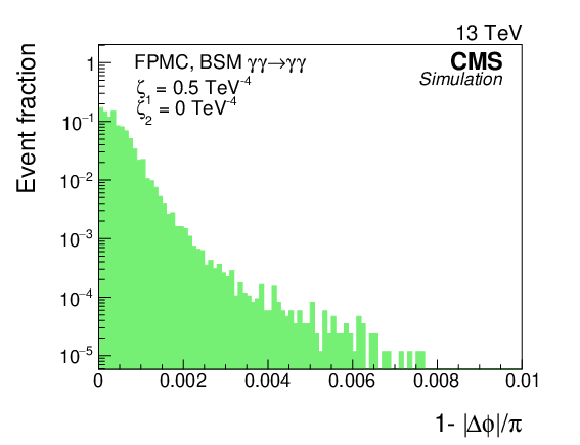
png pdf |
Figure 3-c:
Distribution of the diphoton acoplanarity in simulated aQGC $ \gamma\gamma \to \gamma\gamma $ events. The events are generated with FPMC, reconstructed accounting for the full CMS detector response, for aQGC parameters $ \zeta_1 = $ 0.5 TeV$^{-4} $ and $ \zeta_2 = $ 0 TeV$^{-4} $. A preselection is applied to these events as described in Section 5. |

png pdf |
Figure 3-d:
Kinematic distributions of simulated aQGC $ \gamma\gamma \to \gamma\gamma $ events: Single-photon $ \eta $ (upper left) and $ p_{\mathrm{T}} $ (upper right), and diphoton acoplanarity (lower left) and mass (lower right). The events are generated with FPMC, reconstructed accounting for the full CMS detector response, for aQGC parameters $ \zeta_1 = $ 0.5 TeV$^{-4} $ and $ \zeta_2 = $ 0 TeV$^{-4} $. A preselection is applied to these events as described in Section 5. |

png pdf |
Figure 4:
Kinematic distributions of simulated ALP $ \gamma\gamma \to a \to \gamma\gamma $ events: Single-photon $ \eta $ (upper left) and $ p_{\mathrm{T}} $ (upper right), and diphoton acoplanarity (lower left) and mass (lower right). The events are generated with FPMC, reconstructed accounting for the full CMS detector response, for a value $ f^{-1} =$ 0.1 TeV$^{-1} $ of the ALP-photon coupling. A preselection is applied to these events as described in Section 5. |
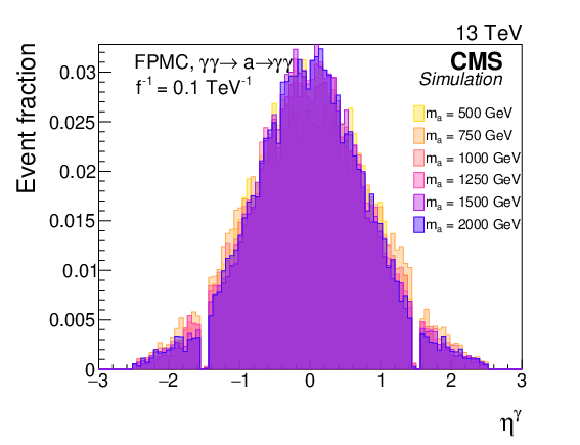
png pdf |
Figure 4-a:
Distribution of single-photon $ \eta $ in simulated ALP $ \gamma\gamma \to a \to \gamma\gamma $ events. The events are generated with FPMC, reconstructed accounting for the full CMS detector response, for a value $ f^{-1} =$ 0.1 TeV$^{-1} $ of the ALP-photon coupling. A preselection is applied to these events as described in Section 5. |
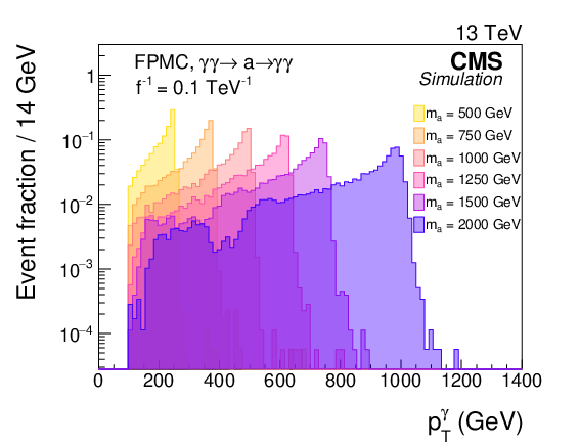
png pdf |
Figure 4-b:
Distribution of single-photon $ p_{\mathrm{T}} $ in simulated ALP $ \gamma\gamma \to a \to \gamma\gamma $ events. The events are generated with FPMC, reconstructed accounting for the full CMS detector response, for a value $ f^{-1} =$ 0.1 TeV$^{-1} $ of the ALP-photon coupling. A preselection is applied to these events as described in Section 5. |
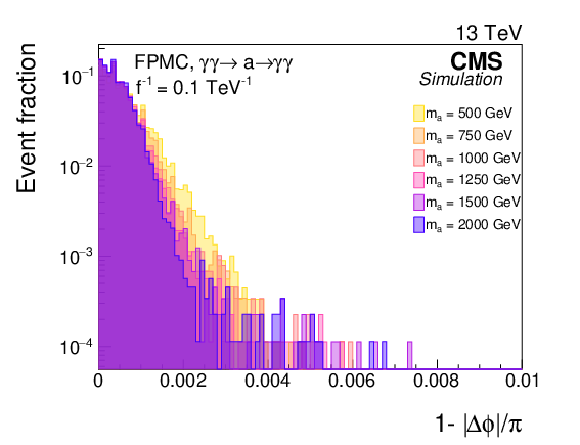
png pdf |
Figure 4-c:
Distribution of diphoton acoplanarity in simulated ALP $ \gamma\gamma \to a \to \gamma\gamma $ events. The events are generated with FPMC, reconstructed accounting for the full CMS detector response, for a value $ f^{-1} =$ 0.1 TeV$^{-1} $ of the ALP-photon coupling. A preselection is applied to these events as described in Section 5. |

png pdf |
Figure 4-d:
Distribution of diphoton mass in simulated ALP $ \gamma\gamma \to a \to \gamma\gamma $ events. The events are generated with FPMC, reconstructed accounting for the full CMS detector response, for a value $ f^{-1} =$ 0.1 TeV$^{-1} $ of the ALP-photon coupling. A preselection is applied to these events as described in Section 5. |

png pdf |
Figure 5:
Number of events in data (black symbols) and simulated backgrounds (histograms) after each of the three consecutive selection criteria applied (upper plot), and ratio of data to sum of all backgrounds (lower plot). The first bin corresponds to the preselection region, the second bin to the acoplanarity criterion, and the third bin to the diphoton $ \xi $ selection defined in the text. The lined red histogram represents an aQGC signal with $ \zeta_1 = $ 0.5 TeV$^{-4} $ and $ \zeta_2 = $ 0.1 TeV$^{-4} $ for reference. Hatched bands indicate systematic uncertainties (statistical uncertainties are smaller than the symbols size). |
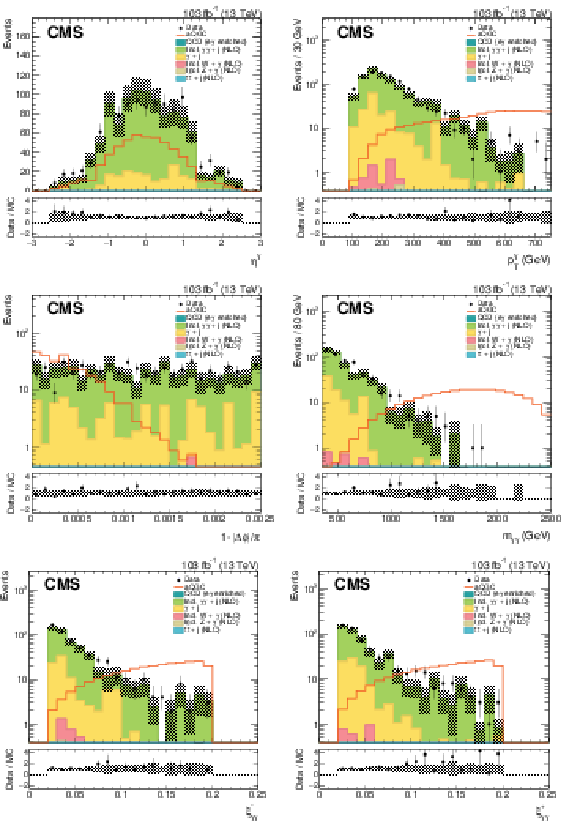
png pdf |
Figure 6:
Kinematic distributions for events passing all selection criteria. From upper to lower and left to right are the single-photon $ \eta $, and $ p_{\mathrm{T}} $, diphoton acoplanarity, mass, $ \xi^{-}_{\gamma\gamma} $, and $ \xi^{+}_{\gamma\gamma} $ distributions. The black dots represent the data, filled histograms represent the simulated SM backgrounds, and the lined red histogram represents an aQGC signal with $ \zeta_1 = $ 50 TeV$^{-4} $ and $ \zeta_2 = $ 100 TeV$^{-4} $ for reference. The lower panels in each plot show the ratio of the number of data events to the total SM background expectation. The dashed box indicates the systematic uncertainties. |

png pdf |
Figure 6-a:
Distribution of the single-photon $ \eta $ for events passing all selection criteria. The black dots represent the data, filled histograms represent the simulated SM backgrounds, and the lined red histogram represents an aQGC signal with $ \zeta_1 = $ 50 TeV$^{-4} $ and $ \zeta_2 = $ 100 TeV$^{-4} $ for reference. The lower panel shows the ratio of the number of data events to the total SM background expectation. The dashed box indicates the systematic uncertainties. |

png pdf |
Figure 6-b:
Distribution of the single-photon $ p_{\mathrm{T}} $ for events passing all selection criteria. The black dots represent the data, filled histograms represent the simulated SM backgrounds, and the lined red histogram represents an aQGC signal with $ \zeta_1 = $ 50 TeV$^{-4} $ and $ \zeta_2 = $ 100 TeV$^{-4} $ for reference. The lower panel shows the ratio of the number of data events to the total SM background expectation. The dashed box indicates the systematic uncertainties. |

png pdf |
Figure 6-c:
Distribution of the diphoton acoplanarity for events passing all selection criteria. The black dots represent the data, filled histograms represent the simulated SM backgrounds, and the lined red histogram represents an aQGC signal with $ \zeta_1 = $ 50 TeV$^{-4} $ and $ \zeta_2 = $ 100 TeV$^{-4} $ for reference. The lower panel shows the ratio of the number of data events to the total SM background expectation. The dashed box indicates the systematic uncertainties. |
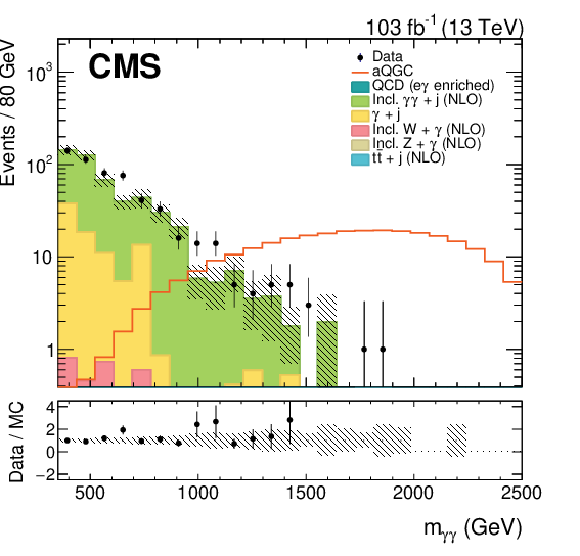
png pdf |
Figure 6-d:
Distribution of the diphoton mass for events passing all selection criteria. The black dots represent the data, filled histograms represent the simulated SM backgrounds, and the lined red histogram represents an aQGC signal with $ \zeta_1 = $ 50 TeV$^{-4} $ and $ \zeta_2 = $ 100 TeV$^{-4} $ for reference. The lower panel shows the ratio of the number of data events to the total SM background expectation. The dashed box indicates the systematic uncertainties. |
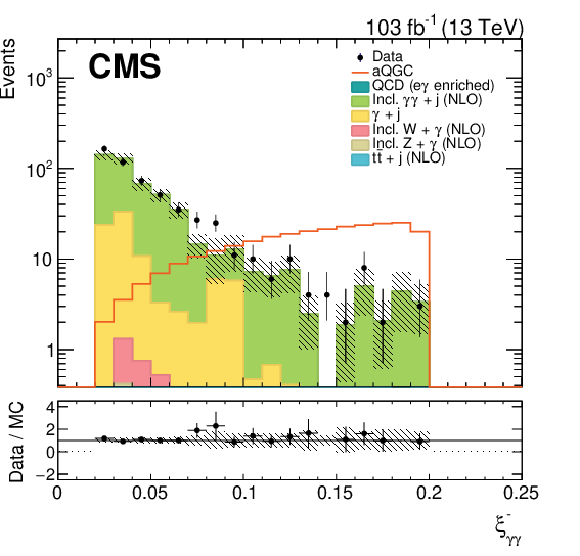
png pdf |
Figure 6-e:
Distribution of the diphoton $ \xi^{-}_{\gamma\gamma} $ for events passing all selection criteria. The black dots represent the data, filled histograms represent the simulated SM backgrounds, and the lined red histogram represents an aQGC signal with $ \zeta_1 = $ 50 TeV$^{-4} $ and $ \zeta_2 = $ 100 TeV$^{-4} $ for reference. The lower panel shows the ratio of the number of data events to the total SM background expectation. The dashed box indicates the systematic uncertainties. |

png pdf |
Figure 6-f:
Distribution of the diphoton $ \xi^{+}_{\gamma\gamma} $ events passing all selection criteria. The black dots represent the data, filled histograms represent the simulated SM backgrounds, and the lined red histogram represents an aQGC signal with $ \zeta_1 = $ 50 TeV$^{-4} $ and $ \zeta_2 = $ 100 TeV$^{-4} $ for reference. The lower panel shows the ratio of the number of data events to the total SM background expectation. The dashed box indicates the systematic uncertainties. |

png pdf |
Figure 7:
Mass versus rapidity matching distributions for events passing the diphoton and diproton selection criteria described in the text. The matching window is shown by a green rectangle corresponding to two standard deviations. |
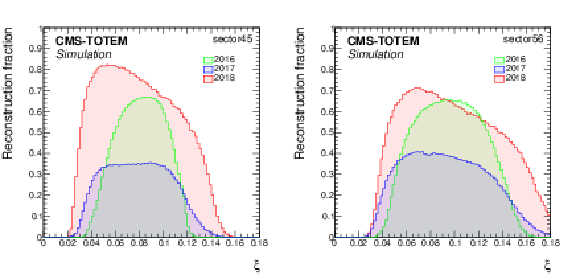
png pdf |
Figure 8:
Distributions of combined efficiency-times-acceptance ($ \epsilon A $) for diffractively scattered protons as a function of the proton $ \xi $ for each running year for PPS sectors 45 (left) and 56 (right), respectively. Differences in the overall reconstruction efficiency are explained by varying detector location, configuration, and design across the years. |
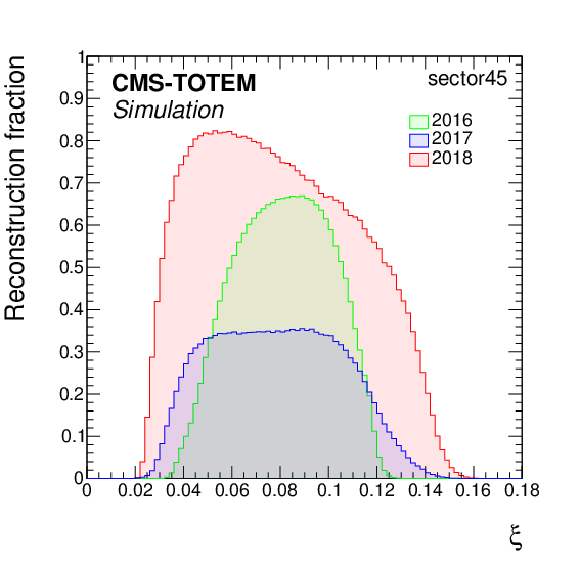
png pdf |
Figure 8-a:
Distribution of the combined efficiency-times-acceptance ($ \epsilon A $) for diffractively scattered protons as a function of the proton $ \xi $ for each running year for PPS sector 45. Differences in the overall reconstruction efficiency are explained by varying detector location, configuration, and design across the years. |
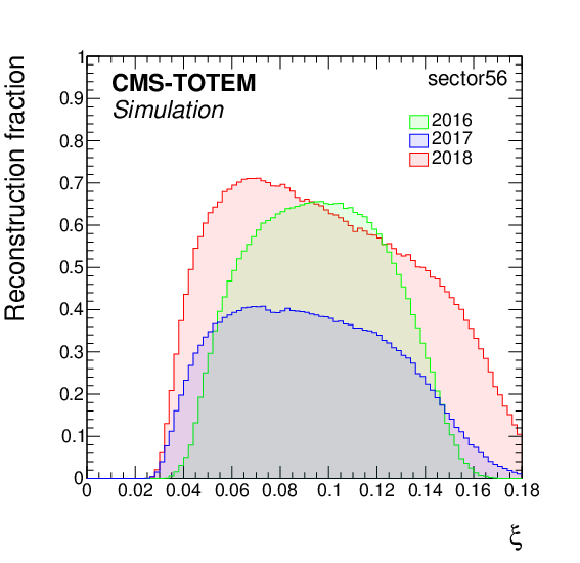
png pdf |
Figure 8-b:
Distribution of the combined efficiency-times-acceptance ($ \epsilon A $) for diffractively scattered protons as a function of the proton $ \xi $ for each running year for PPS sector 56. Differences in the overall reconstruction efficiency are explained by varying detector location, configuration, and design across the years. |
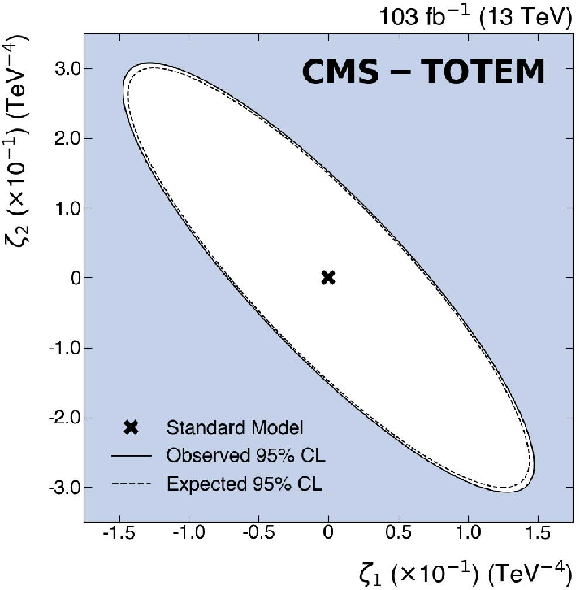
png pdf |
Figure 9:
Observed (solid ellipse) and expected (dashed ellipse) exclusion limits at 95% CL on the anomalous coupling parameters $ \zeta_1 $ and $ \zeta_2 $ derived from the analysis of high-mass exclusive diphoton events in pp collisions at 13 TeV. |

png pdf |
Figure 10:
Product of the ALP efficiency and acceptance ($ \epsilon A $) values as a function of mass $ m_a $ for samples generated with $ f^{-1} = $ 0.1 TeV$^{-1} $ ALP-$ \gamma $ coupling, within the fiducial volume of this search. The curves shown correspond to the PPS $ \epsilon A $ values (dashed curves), as well as the latter convolved with the central-CMS $ \epsilon A $ (solid curves), for each data-taking year and for the full Run-2. |
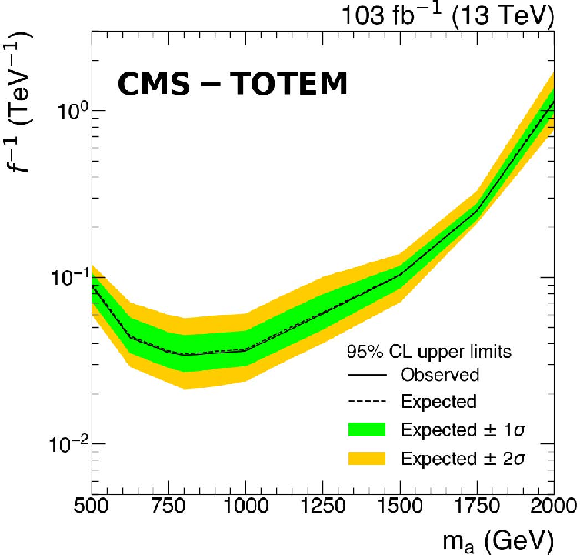
png pdf |
Figure 11:
Upper limits at 95% CL on ALP-photon coupling strength as a function of the ALP mass. The shape of the limit curve is determined by the PPS efficiency-times-acceptance curve. The expected limits almost completely overlap with the observed ones. |
| Tables | |

png pdf |
Table 1:
The input variables to the BDT used in the photon identification process. |

png pdf |
Table 2:
Selection criteria applied to simulated $ \gamma $+jet(s) samples to train the BDT for signal photon identification. |

png pdf |
Table 3:
Summary of the criteria applied to select exclusive diphoton events. |
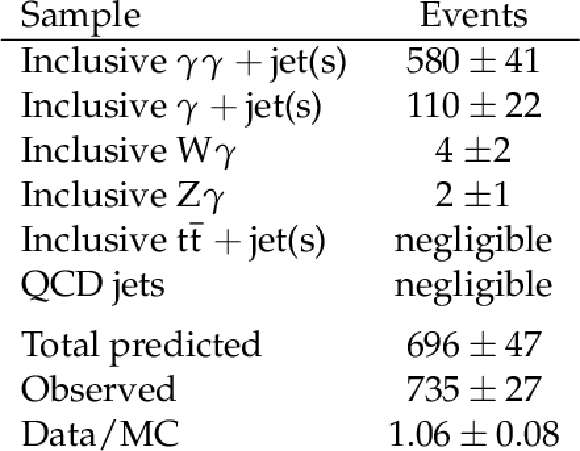
png pdf |
Table 4:
Summary of the predicted number of events for each SM background contributing to the $ \xi \in \text{PPS} $ selection region, their sum, and the observed number of events. The uncertainties quoted are statistical only. |

png pdf |
Table 5:
Systematic uncertainties corresponding to each year of data taking used in the analysis. |

png pdf |
Table 6:
Product of efficiency and acceptance values for each year of data taking, for aQGC signal protons (populating mostly the high-$ \xi $ region in Fig. 8). The second column corresponds to the central CMS detectors, the third column to the PPS, and the fourth column is the product of the two previous ones. |
| Summary |
| A search has been performed for events with a high-mass exclusive diphoton system and two intact protons produced in the final state, $ \mathrm{p}\mathrm{p}\to\mathrm{p}\gamma\gamma\mathrm{p} $, in proton-proton collisions at $ \sqrt{s} = $ 13 TeV. The data set corresponds to an integrated luminosity of 103 fb$ ^{-1} $ collected with the CMS central detectors and the CMS and TOTEM precision proton spectrometer (PPS) in 2016--2018. Light-by-light (LbL) signal events are selected by requiring the measurement of two high-$ p_{\mathrm{T}} $ photons emitted back-to-back, in coincidence with two opposite-side forward protons, measured in PPS, whose kinematic properties match those of the central diphoton system. The data are found to be in agreement with the predicted standard model (SM) background, with one event observed and 1.10 $ \pm $ 0.00 (stat) $ \pm $ 0.24 (syst) events expected. An upper limit on the LbL cross section of $ \sigma(\mathrm{p}\mathrm{p}\to \mathrm{p}\gamma\gamma \mathrm{p}) < $ 0.61 fb is set within the fiducial range of the analysis defined as $ p_{\mathrm{T}}^{\gamma} > $ 100 GeV, $ |\eta^{\gamma}| < $ 2.5, $ m_{\gamma\gamma} > $ 350 GeV, and fractional proton energy loss of 0.035 $ < \xi_{\mathrm{p}} < $ 0.150 (0.180) for the positive-$ z $ (negative-$ z $) arm of PPS. Limits at 95% confidence level are derived for the four-photon anomalous quartic gauge couplings (aQGC) parameters $ |\zeta_1| < $ 0.073 TeV$^{-4} $ and $ |\zeta_2| < $ 0.15 TeV$^{-4} $ (setting, alternatively, the other to zero), using an effective field theory. Additionally, limits on the production of axion-like particles (ALPs) coupling to photons with strengths $ f^{-1} \approx $ 0.03 to 1 TeV$^{-1} $ are set over the mass range from 500 to 2000 GeV. These are the most restrictive limits to date on 4 $ \gamma $ aQGC and on ALPs coupling to photons, in the very high mass phase space region. \newpage |
| References | ||||
| 1 | D. d'Enterria and G. G. da Silveira | Observing light-by-light scattering at the Large Hadron Collider | PRL 111 (2013) 080405 | 1305.7142 |
| 2 | S. Knapen, T. Lin, H. K. Lou, and T. Melia | Searching for axionlike particles with ultraperipheral heavy-ion collisions | PRL 118 (2017) 171801 | 1607.06083 |
| 3 | C. Baldenegro, S. Fichet, G. von Gersdorff, and C. Royon | Searching for axion-like particles with proton tagging at the LHC | JHEP 06 (2018) 131 | 1803.10835 |
| 4 | Y. Kurochkin et al. | On production of magnetic monopoles via $ \gamma\gamma $ fusion at high energy pp collisions | Mod. Phys. Lett. A 21 (2006) 2873 | |
| 5 | D. Atwood, S. Bar-Shalom, and A. Soni | Graviton production by two photon processes in Kaluza-Klein theories with large extra dimensions | hep-ph/9903538 | |
| 6 | S. C. Inan | Direct graviton production via photon-photon fusion at the CERN-LHC | Chin. Phys. Lett. 29 (2012) 031301 | |
| 7 | D. d'Enterria et al. | Collider constraints on massive gravitons coupling to photons | PLB 846 (2023) 138237 | 2306.15558 |
| 8 | J. Ellis, N. E. Mavromatos, and T. You | Light-by-light scattering constraint on Born-Infeld theory | PRL 118 (2017) 261802 | 1703.08450 |
| 9 | S. M. Lietti and C. G. Roldao | Radion and Higgs signals in peripheral heavy ion collisions at the LHC | PLB 540 (2002) 252 | hep-ph/0205256 |
| 10 | CMS Collaboration | Evidence for light-by-light scattering and searches for axion-like particles in ultraperipheral PbPb collisions at $ \sqrt {\smash [b]{s_{_{\mathrm {NN}}}}} = $ 5.02 TeV | PLB 797 (2019) 134826 | CMS-FSQ-16-012 1810.04602 |
| 11 | ATLAS Collaboration | Observation of light-by-light scattering in ultraperipheral Pb+Pb collisions with the ATLAS detector | PRL 123 (2019) 052001 | 1904.03536 |
| 12 | A. J. Baltz | The physics of ultraperipheral collisions at the LHC | Phys. Rept. 458 (2008) 1 | 0706.3356 |
| 13 | R. Bruce et al. | New physics searches with heavy-ion collisions at the CERN Large Hadron Collider | JPG 47 (2020) 060501 | 1812.07688 |
| 14 | S. Fichet et al. | Light-by-light scattering with intact protons at the LHC: from standard model to new physics | JHEP 02 (2015) 165 | 1411.6629 |
| 15 | M. Bauer, M. Neubert, and A. Thamm | Collider probes of axion-like particles | JHEP 12 (2017) 044 | 1708.00443 |
| 16 | R. D. Peccei and H. R. Quinn | CP conservation in the presence of instantons | PRL 38 (1977) 1440 | |
| 17 | P. Agrawal et al. | Feebly-interacting particles: FIPs 2020 workshop report | EPJC 81 (2021) 1015 | 2102.12143 |
| 18 | CMS and TOTEM Collaborations | First search for exclusive diphoton production at high mass with tagged protons in proton-proton collisions at $ \sqrt{s} = $ 13 TeV | PRL 129 (2022) 011801 | CMS-EXO-18-014 2110.05916 |
| 19 | CMS Collaboration | HEPData record for this analysis | link | |
| 20 | CMS Collaboration | Performance of photon reconstruction and identification with the CMS detector in proton-proton collisions at $ \sqrt{s} = $ 8 TeV | JINST 10 (2015) P08010 | CMS-EGM-14-001 1502.02702 |
| 21 | CMS Collaboration | The CMS experiment at the CERN LHC | JINST 3 (2008) S08004 | |
| 22 | CMS Collaboration | Performance of the CMS level-1 trigger in proton-proton collisions at $ \sqrt{s} = $ 13 TeV | JINST 15 (2020) P10017 | CMS-TRG-17-001 2006.10165 |
| 23 | CMS Collaboration | The CMS trigger system | JINST 12 (2017) P01020 | CMS-TRG-12-001 1609.02366 |
| 24 | CMS Collaboration | Particle-flow reconstruction and global event description with the CMS detector | JINST 12 (2017) P10003 | CMS-PRF-14-001 1706.04965 |
| 25 | M. Cacciari, G. P. Salam, and G. Soyez | The anti-$ k_{\mathrm{T}} $ jet clustering algorithm | JHEP 04 (2008) 063 | 0802.1189 |
| 26 | M. Cacciari, G. P. Salam, and G. Soyez | FastJet user manual | EPJC 72 (2012) 1896 | 1111.6097 |
| 27 | CMS Collaboration | Pileup mitigation at CMS in 13 TeV data | JINST 15 (2020) P09018 | CMS-JME-18-001 2003.00503 |
| 28 | CMS and TOTEM Collaborations | CMS-TOTEM Precision Proton Spectrometer | Technical Report CERN-LHCC-2014-021, TOTEM-TDR-003, CMS-TDR-13, 2014 | |
| 29 | LHC Forward Physics Working Group Collaboration | LHC forward physics | JPG 43 (2016) 110201 | 1611.05079 |
| 30 | CMS and TOTEM Collaborations | Proton reconstruction with the CMS-TOTEM Precision Proton Spectrometer | JINST 18 (2023) P09009 | CMS-PRO-21-001 2210.05854 |
| 31 | CMS and TOTEM Collaborations | Observation of proton-tagged, central (semi)exclusive production of high-mass lepton pairs in pp collisions at 13 TeV with the CMS-TOTEM precision proton spectrometer | JHEP 07 (2018) 153 | CMS-PPS-17-001 1803.04496 |
| 32 | CMS Collaboration | Precision luminosity measurement in proton-proton collisions at $ \sqrt{s} = $ 13 TeV in 2015 and 2016 at CMS | EPJC 81 (2021) 800 | CMS-LUM-17-003 2104.01927 |
| 33 | CMS Collaboration | CMS luminosity measurement for the 2017 data-taking period at $ \sqrt{s}= $ 13 TeV | CMS Physics Analysis Summary, 2018 CMS-PAS-LUM-17-004 |
CMS-PAS-LUM-17-004 |
| 34 | CMS Collaboration | CMS luminosity measurement for the 2018 data-taking period at $ \sqrt{s} = $ 13 TeV | Technical Report, 2019 CMS-PAS-LUM-18-002 |
CMS-PAS-LUM-18-002 |
| 35 | J. Alwall et al. | The automated computation of tree-level and next-to-leading order differential cross sections, and their matching to parton shower simulations | JHEP 07 (2014) 079 | 1405.0301 |
| 36 | T. Sjöstrand et al. | An introduction to PYTHIA 8.2 | Comput. Phys. Commun. 191 (2015) 159 | 1410.3012 |
| 37 | CMS Collaboration | Extraction and validation of a new set of CMS PYTHIA8 tunes from underlying-event measurements | EPJC 80 (2020) 4 | CMS-GEN-17-001 1903.12179 |
| 38 | M. Boonekamp et al. | FPMC: a generator for forward physics | 2011 link |
1102.2531 |
| 39 | V. M. Budnev, I. F. Ginzburg, G. V. Meledin, and V. G. Serbo | The two photon particle production mechanism. Physical problems. Applications. Equivalent photon approximation | Phys. Rept. 15 (1975) 181 | |
| 40 | GEANT4 Collaboration | GEANT 4---a simulation toolkit | NIM A 506 (2003) 250 | |
| 41 | CMS Collaboration | Electron and photon reconstruction and identification with the CMS experiment at the CERN LHC | JINST 16 (2021) P05014 | CMS-EGM-17-001 2012.06888 |
| 42 | L. A. Harland-Lang, V. A. Khoze, and M. G. Ryskin | Exclusive physics at the LHC with SuperChic 2 | EPJC 76 (2016) 9 | 1508.02718 |
| 43 | CMS/TOTEM Collaboration | Search for high-mass exclusive $ \gamma\gamma\to\mathrm{WW} $ and $ \gamma\gamma\to\mathrm{ZZ} $ production in proton-proton collisions at $ \sqrt{s} = $ 13 TeV | JHEP 07 (2023) 229 | CMS-SMP-21-014 2211.16320 |
| 44 | T. Junk | Confidence level computation for combining searches with small statistics | NIM A 434 (1999) 435 | hep-ex/9902006 |
| 45 | A. L. Read | Presentation of search results: The CL$ _\text{s} $ technique | JPG 28 (2002) 2693 | |
| 46 | ATLAS and CMS Collaborations and LHC Higgs Combination Group | Procedure for the LHC Higgs boson search combination in summer 2011 | Technical Report CMS-NOTE-2011-005. ATL-PHYS-PUB-2011-11, 2011 | |
| 47 | D. d'Enterria | Collider constraints on axion-like particles | in Workshop on Feebly Interacting Particles, 2021 | 2102.08971 |
| 48 | ATLAS Collaboration | Search for an axion-like particle with forward proton scattering in association with photon pairs at ATLAS | JHEP 07 (2023) 234 | 2304.10953 |

|
Compact Muon Solenoid LHC, CERN |

|

|

|

|

|

|